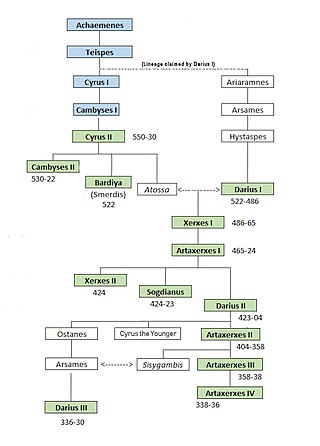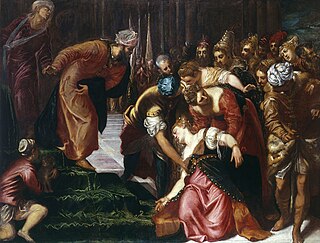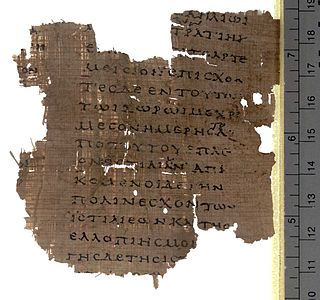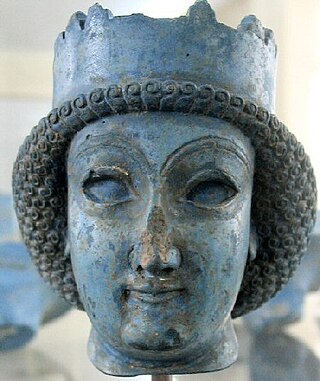Related Research Articles

Xerxes I, commonly known as Xerxes the Great, was a Persian ruler who served as the fourth King of Kings of the Achaemenid Empire, reigning from 486 BC until his assassination in 465 BC. He was the son of Darius the Great and Atossa, a daughter of Cyrus the Great. In Western history, Xerxes is best known for his invasion of Greece in 480 BC, which ended in Persian defeat. Xerxes was designated successor by Darius over his elder brother Artobazan and inherited a large, multi-ethnic empire upon his father's death. He consolidated his power by crushing revolts in Egypt and Babylon, and renewed his father's campaign to subjugate Greece and punish Athens and its allies for their interference in the Ionian Revolt. In 480 BC, Xerxes personally led a large army and crossed the Hellespont into Europe. He achieved victories at Thermopylae and Artemisium before capturing and razing Athens. His forces gained control of mainland Greece north of the Isthmus of Corinth until their defeat at the Battle of Salamis. Fearing that the Greeks might trap him in Europe, Xerxes retreated with the greater part of his army back to Asia, leaving behind Mardonius to continue his campaign. Mardonius was defeated at Plataea the following year, effectively ending the Persian invasion.

Darius II, also known by his given name Ochus, was King of Kings of the Achaemenid Empire from 423 BC to 405 or 404 BC.

The Battle of Salamis was a naval battle fought in 480 BC, between an alliance of Greek city-states under Themistocles, and the Achaemenid Empire under King Xerxes. It resulted in a decisive victory for the outnumbered Greeks. The battle was fought in the straits between the mainland and Salamis, an island in the Saronic Gulf near Athens, and marked the high point of the second Persian invasion of Greece. It was arguably the largest naval battle of the ancient world, and marked a turning point in the invasion.

Ahasuerus is a name applied in the Hebrew Bible to three rulers of Ancient Persia and to a Babylonian official first appearing in the Tanakh in the Book of Esther and later in the Christian Book of Tobit. It is a transliteration of either Xerxes I or Artaxerxes I; both are names of multiple Achaemenid dynasty Persian kings.

Artaxerxes I was the fifth King of Kings of the Achaemenid Empire, from 465 to December 424 BC. He was the third son of Xerxes I.

Leonidas I was a king of the Greek city-state of Sparta, and the 17th of the Agiad line, a dynasty which claimed descent from the mythical demigod Heracles. Leonidas I was a son of the king Anaxandridas II. He succeeded his half-brother King Cleomenes I to the throne in c. 489 BC. His co-ruler was King Leotychidas. He was succeeded by his son, King Pleistarchus.

Bardiya or Smerdis, also named as Tanyoxarces by Ctesias, was a son of Cyrus the Great and the younger brother of Cambyses II, both Persian kings. There are sharply divided views on his life. Bardiya either ruled the Achaemenid Empire for a few months in 522 BCE, or was impersonated by a magus called Gaumata, whose name is given by Ctesias as Sphendadates, until he was toppled by Darius the Great.

The Battle of Thermopylae was fought in 480 BC between the Achaemenid Persian Empire under Xerxes I and an alliance of Greek city-states led by Sparta under Leonidas I. Lasting over the course of three days, it was one of the most prominent battles of both the second Persian invasion of Greece and the wider Greco-Persian Wars.

Atossa was an Achaemenid empress. She was the daughter of Cyrus the Great, and the wife of Darius the Great.
Mardonius was a leading Persian military commander during the Persian Wars with Greece in the early 5th century BC who died at the Battle of Plataea.

The Histories of Herodotus is considered the founding work of history in Western literature. Although not a fully impartial record, it remains one of the West's most important sources regarding these affairs. Moreover, it established the genre and study of history in the Western world.

Vashti was a queen of Persia and the first wife of Persian king Ahasuerus in the Book of Esther, a book included within the Tanakh and the Old Testament which is read on the Jewish holiday of Purim. She was either executed or banished for her refusal to appear at the king's banquet to show her beauty as Ahasuerus wished, and was succeeded as queen by Esther, a Jew. That refusal might be better understood via the Jewish tradition that she was ordered to appear naked. In the Midrash, Vashti is described as wicked and vain; she is viewed as an independent-minded heroine in feminist theological interpretations of the Purim story.

Amestris was an Achaemenid queen, wife of king Xerxes I and mother of king Artaxerxes I.
Parysatis was a Persian queen, consort of Darius II and had a large influence during the reign of Artaxerxes II.

Zopyrus was a Persian nobleman mentioned in Herodotus' Histories.

Masistes was a Persian prince of the Achaemenid Dynasty, son of king Darius I and of his wife Atossa, and full brother of king Xerxes I. He was satrap (governor) of Bactria during his brother's reign, where he attempted to start a revolt in 478 BC.
Artystone also known as Irtašduna in the Fortification tablets, was a Achaemenid princess, daughter of king Cyrus the Great, and sister of Cambyses II, Atossa and Smerdis. Along with Atossa and her niece Parmys, Artystone married king Darius I. It is argued that by marrying the female offspring of Cyrus, the founder of the empire, the new king aimed to prevent his rule from being contested, since Darius himself was not of royal blood.
Darius, was crown prince of the Persian Empire. He was the eldest son of the Persian king Xerxes I and his wife Amestris, the daughter of Otanes. His younger brothers were Hystaspes and Artaxerxes, and his younger sisters were Rhodogune and Amytis.
Mascames, also spelled Maskames was a Persian official and military commander, who flourished during the reign of Xerxes I. He was the son of Megadostes, and was appointed governor of Doriscus in 480 BC by Xerxes I, succeeding the governor who had been appointed by Darius the Great. According to Herodotus, Mascames resisted all Greek attacks following the Second Persian invasion of Greece, and remained thus known as the only remaining Persian governor in Europe. Though the Greeks managed to clear other Persian garrisons in Europe, such as Eion, they were unable to take Doriscus from Mascames, which irked the Athenian military.
Euryanax "eury" meaning wandering, and "anax" meaning king in Dorian, was a son of the Spartan prince Dorieus of the Agiad dynasty, as well as a joint-commander with Pausanias at the Battle of Plataea.
References
- 1 2 Benardete, S. (2012-12-06). Herodotean Inquiries. Springer Science & Business Media. ISBN 978-94-010-3161-5.
- ↑ Sancisi-Weerdenburg, Heleen (2002-01-01), "The Personality of Xerxes, King of Kings", Brill's Companion to Herodotus, Brill, pp. 579–590, ISBN 978-90-04-21758-4 , retrieved 2024-02-23
- ↑ Godley, Alfred Denis (1921–24). "Histories book 9". Herodotus, with an English translation. OCLC 1610641.
- Godley, Alfred Denis (1921–24). "Histories book 9". Herodotus, with an English translation. OCLC 1610641.
- Artaynte (The Histories IX 108-110)